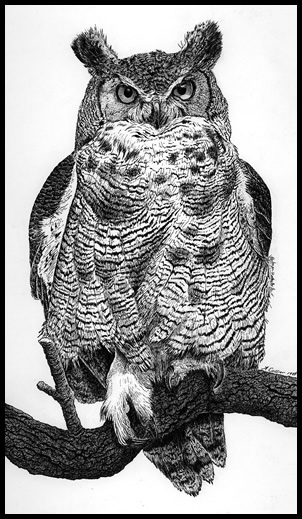| |
| |
| |
| |
| |
| |
| |
| |
| |
| |
| GREAT
HORNED OWL |
 |
| Any description of the great horned owl must contain a number of superlatives. This formidable bird is the largest, most powerful and most aggressive owl resident in our area. At three pounds, the great horned owl is a top predator, capable of taking prey up to the size of skunks and house cats, even porcupines if the bird is hungry enough. Few North American raptors exceed it in size and power. The only owl to do so is the snowy owl (the great gray owl is the longest North American owl, but the bird merely has extraordinarily long, loose plumage - it is outweighed and outpowered by both the snowy and the great horned owl), but the snowy seems to lack the great horned owl's determinedly aggressive temperament. The great horned is a fierce defender of its young, and is one of the very few birds of prey on record as having killed people. The species ranges from the treeline in Canada down to the tip of South America. Throughout this vast range it varies widely in coloration, depending upon the habitat. Northern owls are pale, in striking contrast to birds from the rainy Pacific coast, which can be almost black. Eastern great horned owls are an overall tawny brown, with each feather barred and blotched with dark brown. Like other owls, the great horned is hard to spot once it is perched, since it tends to sit motionless, superbly camouflaged by its cryptic coloration. It may be betrayed by its huge yellow eyes, which are as large as those of people. These golden orbs are set rigidly in bony sockets and cannot be moved, so the owl compensates by turning its neck instead. The neck of the great horned owl has seven more vertebrae than the human neck, resulting in enough extra flexibility to enable the bird to turn its head 270 degrees. Ear tufts, also referred to as plumicorns, are not ears but clumps of feathers that can be raised or lowered at will. They have several functions, one of them to act as the owl's mood communicators. They identify their owner as a great horned owl, an attraction for potential mates and a warning to other owl species that are preyed upon by the great horned. Ear tufts also serve as a camouflage aid. By erecting its plumicorns and pulling its feathers tightly against its body, the owl can look amazingly like a tree branch. The great horned owl begins nesting duties earlier than any other bird in the East - a female may be incubating a clutch of eggs, typically two or three, in a February snowstorm. For several months prior to nesting the mated pair hoot antiphonally, usually in the wee hours of the morning. An adult great horned owl really doesn't have any natural enemies. However, this top predator has long been viewed unfavorably by another top predator - man. The species was still being bountied as recently as the mid-Sixties. Now it is legally protected nationwide, like all other birds of prey, although shooting and trapping still claim victims. Many die each year when they collide with cars while hunting over highways. |